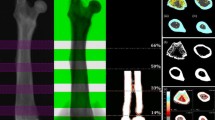Abstract
This study reports on the short-term in vivo precision and absolute measurements of three combinations of whole-body scan modes and analysis software using a Hologic QDR 2000 dual-energy X-ray densito-meter. A group of 21 normal, healthy volunteers (11 male and 10 female) were scanned six times, receiving one pencil-beam and one array whole-body scan on three occasions approximately 1 week apart. The following combinations of scan modes and analysis software were used: pencil-beam scans analyzed with Hologic's standard whole-body software (PB scans); the same pencil-beam analyzed with Hologic's newer “enhanced” software (EPB scans); and array scans analyzed with the enhanced software (EA scans). Precision values (% coefficient of variation, %CV) were calculated for whole-body and regional bone mineral content (BMC), bone mineral density (BMD), fat mass, lean mass, %fat and total mass. In general, there was no significant difference among the three scan types with respect to short-term precision of BMD and only slight differences in the precision of BMC. Precision of BMC and BMD for all three scan types was excellent: <1% CV for whole-body values, with most regional values in the l%–2% range. Pencil-beam scans demonstrated significantly better soft tissue precision than did array scans. Precision errors for whole-body lean mass were: 0.9% (PB), 1.1% (EPB) and 1.9% (EA). Precision errors for whole-body fat mass were: 1.7% (PB), 2.4% (EPB) and 5.6% (EA). EPB precision errors were slightly higher than PB precision errors for lean, fat and %fat measurements of all regions except the head, although these differences were significant only for the fat and % fat of the arms and legs. In addition EPB precision values exhibited greater individual variability than PB precision values. Finally, absolute values of bone and soft tissue were compared among the three combinations of scan and analysis modes. BMC, BMD, fat mass, %fat and lean mass were significantly different between PB scans and either of the EPB or EA scans. Differences were as large as 20%–25% for certain regional fat and BMD measurements. Additional work may be needed to examine the relative accuracy of the scan mode/software combinations and to identify reasons for the differences in soft tissue precision with the array whole-body scan mode.
Similar content being viewed by others
References
Cullum ID, Ell PJ, Ryder JP. X-ray dual-photon absorptiometry: a new method for the measurement of bone density. Br J Radiol 1989;62:587–92.
Mazess RB, Barden HS, Bisek JP, Hanson J. Dual energy x-ray absorptiometry for total-body and regional bone-mineral and soft-tissue composition. Am J Clin Nutr 1990;51:1106–12.
Wahner HW, Dunn WI, Brown ML, et al. Comparison of dual-energy x-ray absorptiometry and dual photon absorptiometry for bone mineral measurements of the lumbar spine. Mayo Clin Proc 1988;63:1075.
Rico H, Revilla M, Villa LF, Hernandez ER, Alvarez de Buergo M, Villa M. Body composition in children and Tanner's stages: a study with dual energy x-ray absorptiometry. Metabolism 1993;42:967–70.
Pederson SB, Borglum JD, Schmitz O, Bak JF, Sorensen NS, Richelsen B. Abdominal obesity in association with insulin resistance and reduced glycogen synthetase activity in skeletal muscle. Metabolism 1993;42:998–1005.
Pritchard JE, Nowson CA, Strauss BJ, Carlson JS, Kaymakci B, Wark JD. Evaluation of dual energy X-ray absorptiometry as a method of measurement of body fat. Eur J Clin Nutr 1993;47:216–28.
Fuller NJ, Laskey MA, Elia M. Assessment of the composition of major body regions by dual-energy X-ray absorptiometry (DEXA), with special reference to limb muscle mass. Clin Physiol 1992;12:253–66.
Russel-Aulet M, Wang J, Thornton J, Pierson R Jr. Comparison of dual-photon absorptiometry systems for total-body and soft tissue measurements: dual-energy x-rays versus gadolinium-153. J Bone Miner Res 1991;6:411–5.
Johnson J, Dawson-Hughes B. Precision and stability of dual-energy x-ray absorptiometry measurements. Calcif Tissue Int 1991;49:174–8.
Blake GM, Parker JC, Buxton FMA, Fogelman I. Dual x-ray absorptiometry: a comparison between fan beam and pencil beam scans. Br J Radiol 1993;66:902–6.
Faulkner KG, Gluer CC, Estilo M, Genant HK. Cross-calibration of DXA equipment: upgrading from a Hologic QDR 1000/W to a QDR 2000. Calcif Tissue Int 1993;52:79–84.
Drinkwater DT, Bailey DA, Faulkner RA, McKay HA. Soft-tissue analysis by DXA: comparison of QDR-1000W and QDR-2000 scanners. J Bone Miner Res 1993;8(Suppl 1):S352.
Kelly, TL, Steiger P, von Stetten E, Stein JA. Performance evaluation of a multidetector DXA device. J Bone Miner Res 1991;6(Suppl 1):S168.
Slosman DO, Rizzoli R, Donath A, Bonjour JP. Bone mineral density of lumbar vertebral body determined in supine and lateral decubitus: study of precision and sensitivity. J Bone Miner Res 1992;7(Suppl 1):S192.
Lewis MK, Blake GM, Fogelman I. Patient dose in dual x-ray absorptiometry. Osteoporosis Int 1994;4:11–5.
Prichard JE, Nowson CA, Strauss BG, Carlson JS, Kaymakci B, Wark JD. Evaluation of dual energy X-ray absorptiometry as a method of measurement of body fat. Eur J Clin Nutr 1993;47:216–28.
Snead DB, Birge SJ, Kohrt W. Age-related differences in body composition by hydrodensitometry and dual-energy X-ray absorptiometry. J Appl Physiol 1993;74:770–5.
Slosman DO, Casez JP, Pichard C, et al. Assessment of whole-body composition with dual-energy x-ray absorptiometry. Radiology 1992;185:593–8.
Author information
Authors and Affiliations
Rights and permissions
About this article
Cite this article
Spector, E., LeBlanc, A. & Shackelford, L. Hologic QDR 2000 whole-body scans: A comparison of three combinations of scan modes and analysis software. Osteoporosis Int 5, 440–445 (1995). https://doi.org/10.1007/BF01626605
Received:
Accepted:
Issue Date:
DOI: https://doi.org/10.1007/BF01626605




